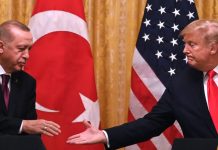Iran’s Air Force has demonstrated the combat capabilities of its Russian-made Yak-130 trainers for the first time, showcasing their operational potential amid reports of possible military strikes by Israel and the United States on Iranian nuclear and missile sites.
In video footage broadcast by Iranian state media, a Yak-130 was seen successfully shooting down an aerial target using a Russian-made R-73 (AA-11 Archer) short-range missile.
The exercise took place during Iran’s large-scale military drills, codenamed “Zolfaqar 1403,” which began on February 22 and covered strategic areas from the northern Indian Ocean to the Makran coasts in southeastern Iran.
Brigadier General Alireza Sheikh, the spokesperson for the drills, described the Yak-130’s performance as “eye-catching and remarkable,” emphasizing its “modern design and high operational capabilities.”
He noted that the aircraft’s inclusion in the exercises was significant because it demonstrated the growing strength of the Iranian Air Force.

As part of the exercise, a Yak-130 operated alongside two MiG-29 fighter jets to intercept an enemy drone. While the MiG-29 pilots identified and tracked the target, the Yak-130 executed the strike, demonstrating its ability to engage aerial threats with advanced missile systems.
The Yak-130 is a subsonic two-seat jet primarily designed for training but also capable of light combat missions. The aircraft was originally developed in partnership with Italy’s Aermacchi.
Iran acquired its first batch of Yak-130 aircraft from Russia in September 2023. The aircraft is also used to train pilots for more advanced fighter jets, including the Russian Su-35 and Su-57.
In January 2025, a senior Revolutionary Guards commander, Brigadier General Ali Shadmani, confirmed the purchase of Russian Su-35 fighter jets from Russia.
At the time, Shadmani warned that if the enemy acted recklessly, it would face the consequences of Iran’s missile strikes, asserting that none of its interests in the occupied territories would be safe—a statement directed at Iran’s regional adversary, Israel.
That development followed a report from Iran’s Tasnim news agency in November 2023, stating that Tehran had finalized a deal to acquire Russian fighter jets.
While details regarding the number of aircraft and their delivery status remain undisclosed, the move reflects Tehran’s efforts to modernize its air force amid rising regional tensions.
Iran Puts Nuclear Facilities On High Alert
The Zolfaqar 1403 drills, involving Iran’s Ground Force, Air Force, Navy, and Air Defense units, come at a time of heightened geopolitical uncertainty.
With speculation over possible military strikes on Iranian nuclear and missile facilities, the display of new air capabilities signals Tehran’s intent to strengthen its defensive posture in an increasingly volatile region.
Iran has placed its nuclear facilities on high alert, bracing for a potential military strike from Israel and the United States, The Telegraph reported. Tehran has reinforced its air defense network by deploying additional missile launchers around key strategic locations.
According to sources cited in the report, Iranian authorities are operating under the assumption that an attack could occur at any time, maintaining heightened security even at undisclosed facilities.
A senior Iranian official admitted that the government is increasingly aware that the country’s existing air defenses, already under strain, may not be capable of withstanding a large-scale assault.
The heightened state of alert follows previous Israeli military operations targeting Iranian assets. Last year, Israel launched a series of airstrikes in retaliation for an Iranian missile attack, striking multiple high-value targets.
These included Iran’s air defense systems, ballistic missile facilities, research centers, and key locations suspected of supporting nuclear weapons development. The strikes were intended to cripple Iran’s military capabilities and deter further aggression.
Iran’s nuclear infrastructure is seen as increasingly vulnerable as many of its regional allies have suffered major setbacks. In November, Israel severely weakened Hezbollah’s operations in Lebanon by eliminating senior commanders, fighters, and weapons depots in a sustained military campaign.
In the wake of these losses, Sunni rebel groups advanced from Idlib, seizing the opportunity to overthrow the Assad regime in Syria. This development effectively cut off Iran’s crucial land corridor to Hezbollah, further isolating Tehran’s military presence in the region.
Concerns over a potential strike on Iran’s nuclear program were further heightened by a recent Washington Post report, which revealed that US intelligence agencies believe Israel is actively considering military action against Iran’s nuclear facilities.
According to the report, these strikes could take place as soon as mid-2025. Despite repeated denials from Iranian leaders that they are pursuing nuclear weapons, Tehran has continued to enrich uranium at levels approaching weapons-grade purity.
Critics argue that uranium enriched to 60% has no viable civilian application, suggesting that Iran is moving closer to developing a nuclear warhead.
Western nations have repeatedly warned that any further progress in Iran’s nuclear program could lead to serious consequences, including possible military intervention.
Iranian President Masoud Pezeshkian responded to the latest reports by asserting that while Iran’s enemies may be able to target its nuclear facilities, they would not succeed in depriving the country of its ability to rebuild them.
- Contact the author at ashishmichel(at)gmail.com
- Follow EurAsian Times on Google News




